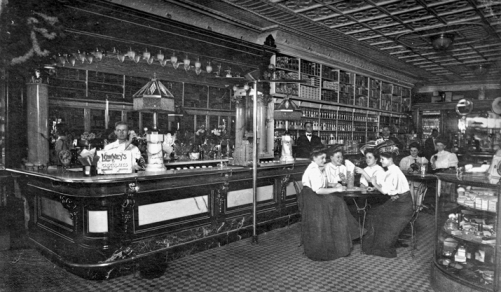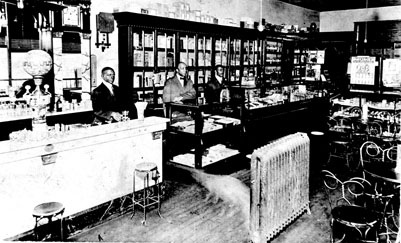Drugstores
Drugstores, or apothecary shops, were scarce in eighteenth-century North Carolina. Solomon Halling and Henry Tooley advertised their New Bern shops in the North-Carolina Gazette in 1784 and 1793, respectively. Their ads listed drugs ranging from the innocuous (chamomile) or useful ("Peruvian bark," or cinchona bark, the source of quinine) to the toxic ("sugar of lead," mercury, and arsenic). They also sold spices such as cinnamon and cloves and patent medicines such as Godfrey's Cordials, Bateman's Drops, Stoughton's Bitters, and Daffy's Elixir. The Moravian settlement at Salem had an apothecary shop at least by the 1780s.
In the nineteenth century, drugstores added a great variety of sidelines or "sundries," a practice that continues. A Wilmington shop in 1839 offered drugs, "medicine chests . . . for family and ship's use," as well as "paints, window glass, shop furniture, and . . . perfumery." By 1850 Wilmington's drugstores also sold chemicals; oil, white lead, and a large selection of pigments for making paint; dye stuffs; "fancy soaps," "fancy rouge," hair tonic, cold cream, shaving cream, and shaving brushes; and stationery, pencils, wallets, and garden seeds. Experienced at making medicines from raw ingredients, pharmacists could also concoct cosmetics and paint.
As late as 1851, there were only 17 drugstores in North Carolina, compared with 110 in Virginia. By 1875 the numbers had grown to include 9 in Wilmington; 6 in New Bern; 5 each in Charlotte and Greensboro; 4 in Raleigh; 3 in Fayetteville; and 1 in Durham. The Greensboro stores included W. C. Porter & Company, owned by the uncle of writer William Sydney Porter, better known as O. Henry. Young Porter was an apprentice druggist in his uncle's shop from 1879 to 1881.
 When carbonated soft drinks became popular in the 1800s, drugstores capitalized by building attractive fountains of fancy ironwork, polished wood, mirrors, and marble. Many drugstores were also ice cream parlors, and pharmacists often turned their talents to preparing their own soft drinks or medicines. Pepsi-Cola was invented by New Bern pharmacist Caleb Bradham. Famous North Carolina medicines include Durham pharmacist Germain Bernard's BC Powder; Vicks VapoRub, invented by Lunsford Richardson of Greensboro; and Salisbury pharmacist Tom Stanback's eponymous headache remedy. To circumvent liquor laws, many people took advantage of drugstores, which could sell liquor if prescribed by a doctor.
When carbonated soft drinks became popular in the 1800s, drugstores capitalized by building attractive fountains of fancy ironwork, polished wood, mirrors, and marble. Many drugstores were also ice cream parlors, and pharmacists often turned their talents to preparing their own soft drinks or medicines. Pepsi-Cola was invented by New Bern pharmacist Caleb Bradham. Famous North Carolina medicines include Durham pharmacist Germain Bernard's BC Powder; Vicks VapoRub, invented by Lunsford Richardson of Greensboro; and Salisbury pharmacist Tom Stanback's eponymous headache remedy. To circumvent liquor laws, many people took advantage of drugstores, which could sell liquor if prescribed by a doctor.
Drugstores added many new sidelines in the twentieth century. White's Drug Store in Greenville listed "Huyler's chocolates and bon-bons and a full line of Eastman Kodak supplies" in a 1911 flyer. Davis Pharmacy in Marion advertised a huge list of "holiday suggestions" that included games, books, toy trains, shaving sets, fountain pens, box cigars, electrical toys, flashlights, photo albums, music rolls, cut glass, and hand-painted china. Around this time, Williams Pharmacy in Canton began selling gasoline to local automobile drivers.
Established druggists, especially in the post-World War II years, faced competition from new "discount" or "cut-rate" stores as well as growing regional or national chains. By the start of the twenty-first century, North Carolina had more than 500 independent retail drugstores and nearly 1,000 chain stores, plus a few hundred more pharmacies in hospitals, clinics, nursing homes, and other facilities.
Kerr Drug, which began when Banks Kerr opened a drugstore in 1951 in Raleigh's Cameron Village, is the only drugstore chain based in the Carolinas. After being sold to JC Penney in 1995, the Kerr name and 154 stores were bought the following year by former Thrift Drug, Inc., executives. Florida-based Eckerd and Rhode Island-based CVS are among the major national chains with many stores in North Carolina.
1 January 2006 | Norris, David A.